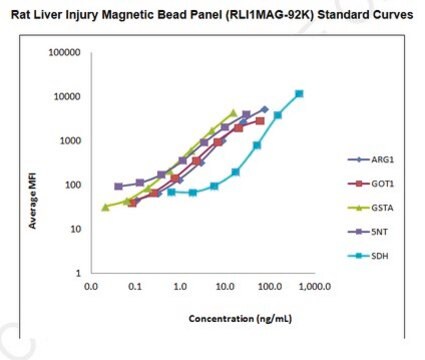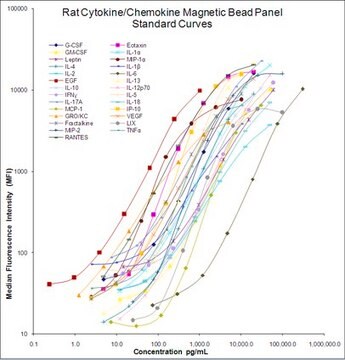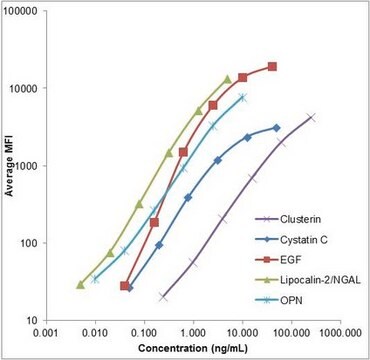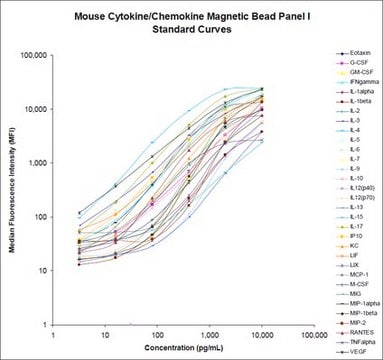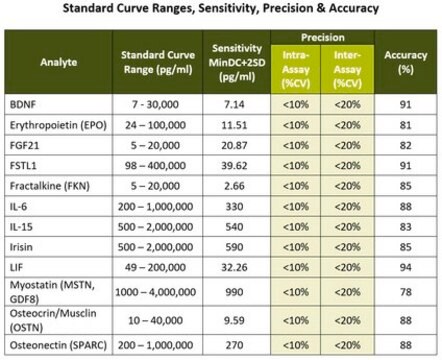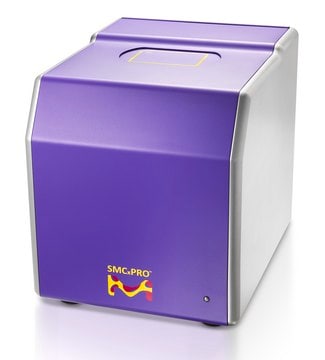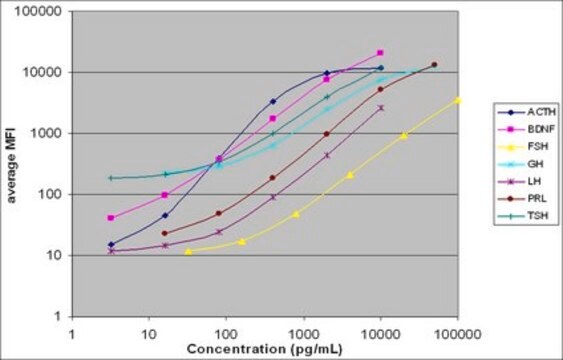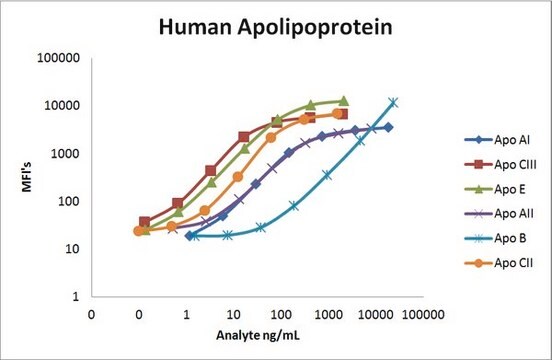RCI1MAG-87K
MILLIPLEX® Rat Cardiac Injury Panel 1 - Cardiotoxicity Multiplex Assay
About This Item
Prodotti consigliati
Reattività contro le specie
rat
Livello qualitativo
Produttore/marchio commerciale
Milliplex®
assay range
recovery range: 80-100%
(2 Hour Protocol)
recovery range: 86-103%
(Overnight Protocol)
sensitivity: 7-155 pg/mL
(Overnight Protocol; MinDC+2SD)
sensitivity: 9-86 pg/mL
(2 Hour Protocol; MinDC+2SD)
standard curve range: 123-90,000 pg/mL
(cTnI)
standard curve range: 21-15,000 pg/mL
(CKM)
standard curve range: 4-3,000 pg/mL
(MYL3)
standard curve range: 41-30,000 pg/mL
(FABP3)
standard curve range: 41-30,000 pg/mL
(TIMP-1)
standard curve range: 82-60,000 pg/mL
(FSTL1)
standard curve range: 82-60,000 pg/mL
(cTnT)
tecniche
multiplexing: suitable
Metodo di rivelazione
fluorometric (Luminex xMAP)
Condizioni di spedizione
wet ice
Categorie correlate
Descrizione generale
In order to meet the increasing need to provide screening assays for experimental biomarkers of drug-induced cardiac injury in pre-clinical and translational research models, we have developed the MILLIPLEX® Rat Cardiac Injury Bead Panel 1. This configurable 7-plex panel is the most versatile system available for cardiac injury screening in pre-clinical and translational research models.
The MILLIPLEX® Rat Cardiac Injury Bead Panel 1 (RCI1MAG-87K) contains all the components necessary to simultaneous quantify any or all of the following 7 analytes in serum and plasma samples: Cardiac Troponin I (cTnI), Cardiac Troponin T (cTnT), Creatine Kinase, Muscle (CKM), Fatty Acid Binding Protein 3 (FABP3), Follistatin-like Protein 1 (FSTL1), Myosin Light Chain 3 (MYL3), Tissue Inhibitor of Metalloproteinase-1 (TIMP-1).
This kit uses a 96-well format, contains lyophilized standard cocktail and two quality controls, and can measure up to 38 serum or plasma samples in duplicate.
Panel Type: Toxicity
Specificità
There was no or negligible cross-reactivity between the antibodies for an analyte and any of the other analytes within a panel.
Applicazioni
- Analytes: Cardiac Troponin I (cTnI), Cardiac Troponin T (cTnT), Creatine Kinase Muscle (CKM), Fatty Acid Binding Protein 3 (FABP3), Follistatin-like Protein 1 (FSTL1), Myosin Light Chain 3 (MYL3), Tissue Inhibitor of Metalloproteinase-1 (TIMP-1)
- Recommended Sample Type: Rat serum or plasma
- Recommended Sample dilution: 25 μL per well of 1:5 diluted serum or plasma
- Assay Run Time: Overnight (16-18 hours) at 2-8°C or 2 hours at room temperature (20-25°C).
- Research Category: Toxicity
- Research Subcategory: Cardiovascular
Caratteristiche e vantaggi
Confezionamento
Componenti
Rat Cardiac Injury Quality Control 1, 1 vial, lyophilized
Rat Cardiac Injury Quality Control 2, 1 vial, lyophilized
Serum Matrix (0.08% Sodium Azide), 1 vial, lyophylized
Assay Buffer, 1 bottle, 30 mL
Wash Buffer, 10X (0.05% Proclin), 2 bottles, 30 mL ea
Rat Cardiac Injury Panel 1 Detection Antibodies, 1 bottle, 3.2 mL
Rat Cardiac Injury Panel 1 Antibody-Immobilized Beads (20X), 200 µL ea
Streptavidin-Phycoerythrin, 1 bottle, 3.2 mL
Mixing Bottle, 1 bottle
Sample Plate, 96 well format, 1 plate
2 Foil Plate Sealers
Stoccaggio e stabilità
Altre note
Note legali
Esclusione di responsabilità
Avvertenze
Danger
Indicazioni di pericolo
Classi di pericolo
Acute Tox. 3 Dermal - Acute Tox. 4 Inhalation - Acute Tox. 4 Oral - Aquatic Chronic 2 - Eye Dam. 1 - Skin Sens. 1 - STOT RE 2
Organi bersaglio
Respiratory Tract
Codice della classe di stoccaggio
6.1C - Combustible acute toxic Cat.3 / toxic compounds or compounds which causing chronic effects
Certificati d'analisi (COA)
Cerca il Certificati d'analisi (COA) digitando il numero di lotto/batch corrispondente. I numeri di lotto o di batch sono stampati sull'etichetta dei prodotti dopo la parola ‘Lotto’ o ‘Batch’.
Possiedi già questo prodotto?
I documenti relativi ai prodotti acquistati recentemente sono disponibili nell’Archivio dei documenti.
Contenuto correlato
Uncover tips and tricks to multiplexing in this guide from the experts. Learn how you can enhance the power of your research with MILLIPLEX® multiplexing, including industry guidance for immunoassays, multiplexing tips, one-day MILLIPLEX® multiplex assays for limited lab time, and more.
Learn the benefits of using biomarker detection multiplex immunoassays for laboratory, companion, and agricultural animal research and explore MILLIPLEX® multiplex assays for veterinary medicine and animal health research.
Il team dei nostri ricercatori vanta grande esperienza in tutte le aree della ricerca quali Life Science, scienza dei materiali, sintesi chimica, cromatografia, discipline analitiche, ecc..
Contatta l'Assistenza Tecnica.